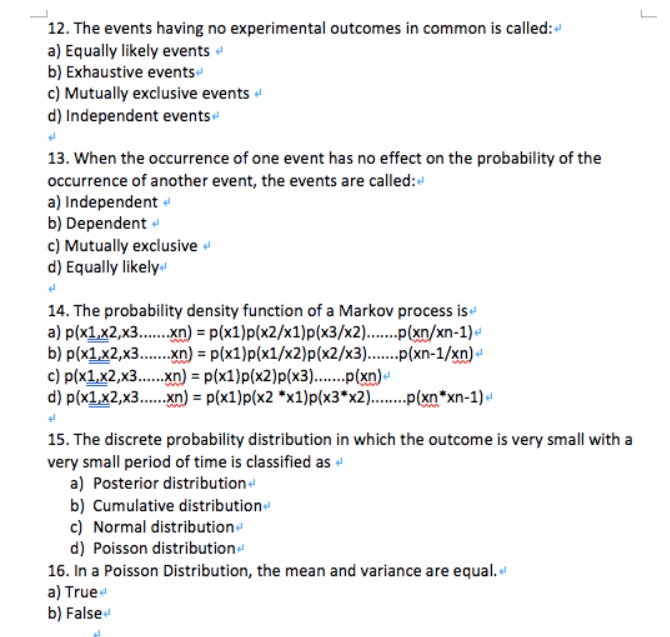14. The probability density function of a Markov process is a) p(x1,x2,x3..xn) = p(x1)p(x2/x1)p(x3/x2)...p(xn/xn-1)« b) p(x1,x2,x3..xn) = p(x1)p(x1/x2)p(x2/x3......(xn-1/xn)- c) p(x1,x2,x3..xn) = p(x1)p(x2)p(x3)..p(xn)« d) p(x1,x2,x3...xn) = p(x1)p(x2 *x1)p(x3*x2)....(xn*xn-1)« %3D
14. The probability density function of a Markov process is a) p(x1,x2,x3..xn) = p(x1)p(x2/x1)p(x3/x2)...p(xn/xn-1)« b) p(x1,x2,x3..xn) = p(x1)p(x1/x2)p(x2/x3......(xn-1/xn)- c) p(x1,x2,x3..xn) = p(x1)p(x2)p(x3)..p(xn)« d) p(x1,x2,x3...xn) = p(x1)p(x2 *x1)p(x3*x2)....(xn*xn-1)« %3D
Linear Algebra: A Modern Introduction
4th Edition
ISBN:9781285463247
Author:David Poole
Publisher:David Poole
Chapter3: Matrices
Section3.7: Applications
Problem 12EQ:
12. Robots have been programmed to traverse the maze shown in Figure 3.28 and at each junction...
Related questions
Question
solve question 14 with complete explanation typed

Transcribed Image Text:12. The events having no experimental outcomes in common is called:
a) Equally likely events e
b) Exhaustive events
c) Mutually exclusive events e
d) Independent events
13. When the occurrence of one event has no effect on the probability of the
occurrence of another event, the events are called:
a) Independent e
b) Dependent e
c) Mutually exclusive e
d) Equally likelye
14. The probability density function of a Markov process is
a) p(x1,x2,x3..xn) = p(x1)p(x2/x1)p(x3/x2)...p(xn/xn-1)e
b) p(x1,x2,x3.xn) = p(x1)p(x1/x2)p(x2/x3)..p(xn-1/xn)-
c) p(x1,x2,x3..xn) = p(x1)p(x2)p(x3)..p(xn)e
d) p(x1,x2,x3...xn) = p(x1)p(x2 *x1)p(x3*x2)...p(xn*xn-1)e
..xn) =
.....
15. The discrete probability distribution in which the outcome is very small with a
very small period of time is classified as «
a) Posterior distribution
b) Cumulative distributione
c) Normal distributione
d) Poisson distributione
16. In a Poisson Distribution, the mean and variance are equal.
a) True
b) False
Expert Solution
This question has been solved!
Explore an expertly crafted, step-by-step solution for a thorough understanding of key concepts.
Step by step
Solved in 2 steps

Recommended textbooks for you

Linear Algebra: A Modern Introduction
Algebra
ISBN:
9781285463247
Author:
David Poole
Publisher:
Cengage Learning

Algebra & Trigonometry with Analytic Geometry
Algebra
ISBN:
9781133382119
Author:
Swokowski
Publisher:
Cengage

Elementary Linear Algebra (MindTap Course List)
Algebra
ISBN:
9781305658004
Author:
Ron Larson
Publisher:
Cengage Learning

Linear Algebra: A Modern Introduction
Algebra
ISBN:
9781285463247
Author:
David Poole
Publisher:
Cengage Learning

Algebra & Trigonometry with Analytic Geometry
Algebra
ISBN:
9781133382119
Author:
Swokowski
Publisher:
Cengage

Elementary Linear Algebra (MindTap Course List)
Algebra
ISBN:
9781305658004
Author:
Ron Larson
Publisher:
Cengage Learning